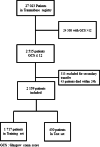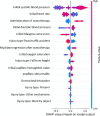Machine learning-based prediction of emergency neurosurgery within 24 h after moderate to severe traumatic brain injury
- PMID: 35922831
- PMCID: PMC9351267
- DOI: 10.1186/s13017-022-00449-5
Machine learning-based prediction of emergency neurosurgery within 24 h after moderate to severe traumatic brain injury
Abstract
Background: Rapid referral of traumatic brain injury (TBI) patients requiring emergency neurosurgery to a specialized trauma center can significantly reduce morbidity and mortality. Currently, no model has been reported to predict the need for acute neurosurgery in severe to moderate TBI patients. This study aims to evaluate the performance of Machine Learning-based models to establish to predict the need for neurosurgery procedure within 24 h after moderate to severe TBI.
Methods: Retrospective multicenter cohort study using data from a national trauma registry (Traumabase®) from November 2011 to December 2020. Inclusion criteria correspond to patients over 18 years old with moderate or severe TBI (Glasgow coma score ≤ 12) during prehospital assessment. Patients who died within the first 24 h after hospital admission and secondary transfers were excluded. The population was divided into a train set (80% of patients) and a test set (20% of patients). Several approaches were used to define the best prognostic model (linear nearest neighbor or ensemble model). The Shapley Value was used to identify the most relevant pre-hospital variables for prediction.
Results: 2159 patients were included in the study. 914 patients (42%) required neurosurgical intervention within 24 h. The population was predominantly male (77%), young (median age 35 years [IQR 24-52]) with severe head injury (median GCS 6 [3-9]). Based on the evaluation of the predictive model on the test set, the logistic regression model had an AUC of 0.76. The best predictive model was obtained with the CatBoost technique (AUC 0.81). According to the Shapley values method, the most predictive variables in the CatBoost were a low initial Glasgow coma score, the regression of pupillary abnormality after osmotherapy, a high blood pressure and a low heart rate.
Conclusion: Machine learning-based models could predict the need for emergency neurosurgery within 24 h after moderate and severe head injury. Potential clinical benefits of such models as a decision-making tool deserve further assessment. The performance in real-life setting and the impact on clinical decision-making of the model requires workflow integration and prospective assessment.
Keywords: Artificial intelligence; Emergency neurosurgery; Prediction models; Trauma; Traumatic brain injury.
© 2022. The Author(s).
Conflict of interest statement
TG declares consulting fees from Laboratoire du Biomédicament in the past.
Figures





Similar articles
-
Impact of Glasgow Coma Scale score and pupil parameters on mortality rate and outcome in pediatric and adult severe traumatic brain injury: a retrospective, multicenter cohort study.J Neurosurg. 2017 Mar;126(3):760-767. doi: 10.3171/2016.1.JNS152385. Epub 2016 Apr 1. J Neurosurg. 2017. PMID: 27035177
-
Predicting the Individual Treatment Effect of Neurosurgery for Patients with Traumatic Brain Injury in the Low-Resource Setting: A Machine Learning Approach in Uganda.J Neurotrauma. 2021 Apr 1;38(7):928-939. doi: 10.1089/neu.2020.7262. Epub 2020 Dec 14. J Neurotrauma. 2021. PMID: 33054545
-
Application of machine learning to predict the outcome of pediatric traumatic brain injury.Chin J Traumatol. 2021 Nov;24(6):350-355. doi: 10.1016/j.cjtee.2021.06.003. Epub 2021 Jun 8. Chin J Traumatol. 2021. PMID: 34284922 Free PMC article.
-
Decision making in very severe traumatic brain injury (Glasgow Coma Scale 3-5): a literature review of acute neurosurgical management.J Neurosurg Sci. 2018 Apr;62(2):153-177. doi: 10.23736/S0390-5616.17.04255-2. Epub 2017 Nov 10. J Neurosurg Sci. 2018. PMID: 29125266 Review.
-
Applications of machine learning in pediatric traumatic brain injury (pTBI): a systematic review of the literature.Neurosurg Rev. 2024 Oct 5;47(1):737. doi: 10.1007/s10143-024-02955-3. Neurosurg Rev. 2024. PMID: 39367894
Cited by
-
Machine Learning Approach for the Prediction of In-Hospital Mortality in Traumatic Brain Injury Using Bio-Clinical Markers at Presentation to the Emergency Department.Diagnostics (Basel). 2023 Aug 5;13(15):2605. doi: 10.3390/diagnostics13152605. Diagnostics (Basel). 2023. PMID: 37568968 Free PMC article.
-
Machine learning-based models to predict the need for neurosurgical intervention after moderate traumatic brain injury.Health Sci Rep. 2023 Oct 29;6(11):e1666. doi: 10.1002/hsr2.1666. eCollection 2023 Nov. Health Sci Rep. 2023. PMID: 37908638 Free PMC article.
-
Artificial Intelligence-Enhanced Neurocritical Care for Traumatic Brain Injury : Past, Present and Future.J Korean Neurosurg Soc. 2024 Sep;67(5):493-509. doi: 10.3340/jkns.2023.0195. Epub 2024 Jan 8. J Korean Neurosurg Soc. 2024. PMID: 38186369 Free PMC article.
-
Computational Prognostic Modeling in Traumatic Brain Injury.Adv Exp Med Biol. 2024;1462:475-486. doi: 10.1007/978-3-031-64892-2_29. Adv Exp Med Biol. 2024. PMID: 39523284 Review.
-
An early screening model for preeclampsia: utilizing zero-cost maternal predictors exclusively.Hypertens Res. 2024 Apr;47(4):1051-1062. doi: 10.1038/s41440-023-01573-8. Epub 2024 Feb 7. Hypertens Res. 2024. PMID: 38326453 Free PMC article.
References
-
- Roquilly A, Moyer JD, Huet O, Lasocki S, Cohen B, Dahyot-Fizelier C, et al. Effect of continuous infusion of hypertonic saline vs standard care on 6-month neurological outcomes in patients with traumatic brain injury: the COBI randomized clinical trial. JAMA. 2021;325:2056–2066. doi: 10.1001/jama.2021.5561. - DOI - PMC - PubMed
-
- Cooper DJ, Nichol AD, Bailey M, Bernard S, Cameron PA, Pili-Floury S, et al. Effect of early sustained prophylactic hypothermia on neurologic outcomes among patients with severe traumatic brain injury: the POLAR randomized clinical trial. JAMA. 2018;320:2211–2220. doi: 10.1001/jama.2018.17075. - DOI - PMC - PubMed
Publication types
MeSH terms
LinkOut - more resources
Full Text Sources
Medical

